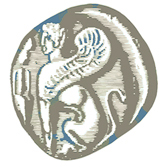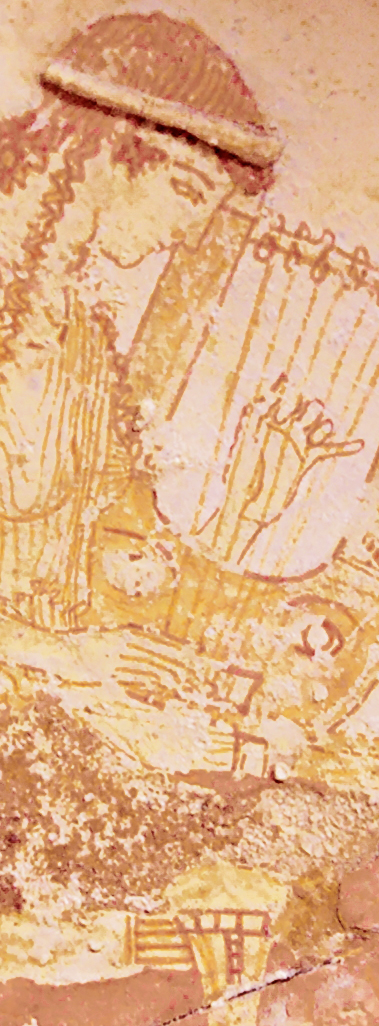One of the
biggest problems for someone who starts to deal
with the Byzantine Music is the relatively
complex theory and the almost complete lack of a
reliable and free program to experiment, to
listen, learn, write and of course to create
Byzantine Music using it.
This is the gap that we tried to cover with this site which we kindly offer to our students, to those studying our music and to all lovers of our tradition. In the future, we hope to build a notable music base with compositions and composers covering all the Greek music culture mainly from the Byzantine period and beyond. However, it is not impossible to find partners-experts in Ancient Greek Music, as well. It is well known what an important role music played in the soul of young people since the antiquity. The accompaniment of flutes was necessary both while the young were exercising and during the official competitions. Besides the sports competitions there had been kitharodeias competitions since 586 BC! Our ancestors knew how to combine mathematics with music, sports, the arts, education and everyday life in general. The ancient Greek philosophers consider music necessary for three reasons:
At that time, the cultured man was also called musician man(μουσικός ανήρ). Themistocles admitted that his education was incomplete because he had not learned music well, as we are informed by Plutarch.
Our Byzantine music offered and offers a serious and constant link with our ecclesiastical tradition of many centuries, with our traditional Leventiki music as well as with the ancient Greek music. It is known to all those engaged with Byzantine music, the Byzantine system of octave (4 main and 4 plagal tones) resting directly on the moral-emotional system of music that the ancient Greeks had developed. Genera (=plural of genus) in Byzantine music are divided into three groups (diatonic, chromatic, harmonic) as in ancient times. The forerunner of the ecclesiastical organ that passed through the Byzantine Empire to the West was ydralis(ύδραλις), while pandourida (the Pandoura,πανδουρίδα) is the forerunner of the lute and bouglari. The Pandoura is still used even today in the teaching of scales, microtonals etc. of Byzantine Music. Today, nowhere can we listen to the exact sounds of ancient music except for the chants and hymns of the Byzantine Music and the songs of our traditional music. Example: The scale intervals we listen to today in ecclesiastical members of the diatonic genus are those set by Didymus from Alexandria. The syntonic comma (i.e. 81/80 =around 21.54 cents) is also known by his name. More about the diatonic genus as well as other useful information can be found in the Encyclopedia of microtonal music theory(*).
Fathers of the Church stressed the important role of music for the revival/restoration/reconstruction of human nature and opposed to its misuse for the distasteful and unworthy entertainment and naturally to its commercialization. Characteristic is the following passage from the Contra Julianum imperatorem 2 (Against Julian):
Ἀναλάβωμεν ὕμνους ἀντὶ τυμπάνων, ψαλμῳδίαν ἀντὶ τῶν αἰσχρῶν λυγισμάτων τε καὶ ᾀσμάτων, κρότον εὐχαριστήριον ἀντὶ κρότων θεατρικῶν, καὶ χειρῶν πρᾶξιν εὔηχον, σύννοιαν ἀντὶ γέλωτος, ἀντὶ μέθης ἔμφρονα λόγον, ἀντὶ θρύψεως σεμνοπρέπειαν. Εἰ καὶ ὀρχήσασθαι δεῖ σε, ὡς πανηγυριστὴν καὶ φιλέορτον, ὄρχησαι μὲν, ἀλλὰ μὴ τὴν Ἡρωδιάδος ὄρχησιν τῆς ἀσχήμονος, ἧς ἔργον Βαπτιστοῦ θάνατος· ἀλλὰ τὴν Δαβὶδ ἐπὶ τῇ καταπαύσει τῆς κιβωτοῦ, ἣν ἡγοῦμαι τῆς εὐκινήτου καὶ πολυστρόφου κατὰ Θεὸν πορείας εἶναι μυστήριον. Πρῶτον μὲν δὴ τοῦτο καὶ μέγιστον τῆς ἐμῆς παραινέσεως.
We started the construction of this site in
August 2015. After a very fruitful
collaboration with the Canadian Mr. Seymour
Shlien, we managed to write and listen to
(finally!) Byzantine music using abcnotation
and abc2midi. Abcnotation is a smart
philosophy to enable anyone to write music
without instruments, microphones
installations, or expensive synthesizers. Just
by using our computer keyboard where instead
of writing syllables or sentences, we write
one by one the notes (for example, note Ni
i.e. Do is simply represented simply by the
letter C). After we write our melody and add
the appropriate "cosmetic" commands we can
print and of course listen to it! Printing ie.
viewing in the stave is supported by a free
program called abcm2ps. Of course in this
case, the stave does not interest us very much
because traditionally we write our music with
the established symbols of Byzantine notation
(and five years now, free or commercial
software has been developed rudimentary
covering this need). The challenge is how to
listen to our music, its scales and its
quality characters, or in other words how we
would attribute/represent it correctly. At
this point, the abc2midi free program came
along converting notes into sounds written in
C language- the exquisite creature of Mr.
Shlien. |
 In this site we will find all the instructions to write and listen to Byzantine music on the pentagram with the abcnotation notation. We have also developed a musical text authoring methodology to purely Byzantine notation with powerful free XeLaTeX language that is used by thousands of scientists from around the world to produce scientific texts of unparalleled precision and beauty. We hereby declare that we can not achieve perfection in the writing and printing of a musical text in Byzantine notation unless we use some of the free tools of the family called TeX. (This tool was built in the 80s by one of the largest computer programmers of all time Mr. Donald Knuth). Of course, it would be a great honor for us if the above methodologies of the Byzantine music approach were adopted by our readers. Your only legal obligation, but also our own moral satisfaction in the countless "man hours" that we consumed, would be to send us your musical work for publication on this website as well as the immediate reference of the website in any electronic or other publication of yours. Some biographical information about Mr. Shlien. For eight years now, he is retired and exclusively supports the runabc and abc2midi. He was a research scientist at the Communications Research Center (CRC) in Ottawa, Canada. In the last five years before his retirement, he worked on audio coding, psychoacoustics and music information retrieval. The sitemap is the following: The button Εργαλεία Βυζαντινής Μουσικής/Byzantine Music Tools gives instructions on how to write Byzantine music with abcnotation and XeLaTeX. The button Βυζαντινή Μουσική/Byzantine Music gives information about the Byzantine music as well as musical compositions, composers of ecclesiastical members and traditional songs (written in abc and XeLaTeX) The button Σύγχρονη Ελληνική Μουσική/Greek Contemporary Music in the future will include compositions and composers that have been inspired by our Byzantine and traditional folk music. Finally, the button Σύνδεσμοι/Links shows other pages related to this website and our supporters and motivators. |
| Free Software(*) for writing the Byzantine Music on the pentagram using the abc. |
| Free Software(*)
for writing the Byzantine Music in the traditional
Byzantine notation using XeLaTeX. |
| (*) Click on the words written in bold to enter the corresponding page. |


